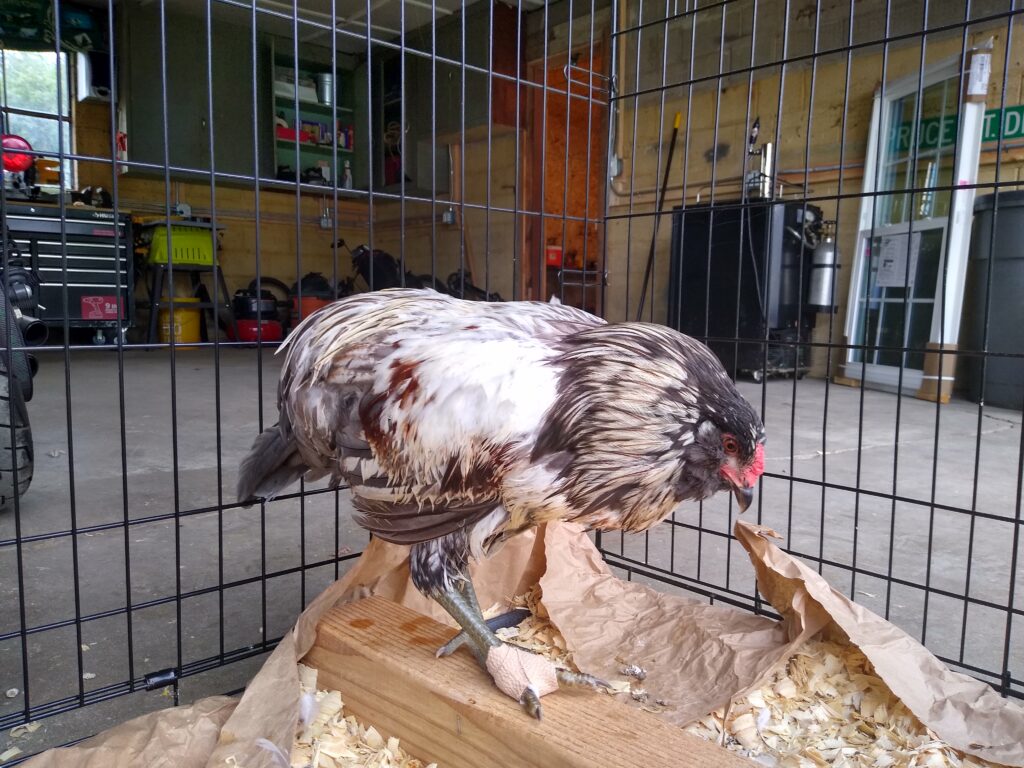While this post does not have graphic images, it does describe (in detail) chicken ailments. The end of the article includes recommendations for a Chicken First Aid Kit.
Symptoms
If you’re like me, your pet’s health is something covered by your trusted veterinarian. Your dog can’t keep food down, or wakes you up with a swollen eye, and you ring up your vet and see when you can head in. With chickens, it’s hard to find a vet that will agree to see them. What I’m looking for is an “exotic” animal vet, and they’re not at every clinic! Thankfully, a clinic close to us has one of these specialized vets, but that means her time is hard to get.
Two weeks ago, Lil Roo didn’t move when Chris came to the chicken coop. Unusual. So we picked him up and brought him to the house for medical isolation. Maybe he had a sprained ankle. Maybe he had bumblefoot. Either way, he needs special attention, and time away from the flock. Chickens can be vicious, as we’ve learned. If they can see blood, they will fixate and further an injury on another bird, including when they made the initial injury.
We set up a dog crate for Lil Roo, that has pine shavings, water, and food, and a short 4×4 as a perch. This has been his private HnH hospital room since we first saw something was off. His foot progressed from limping to swollen and ugly.

Diagnosis
Generally, superficial foot ailments in chickens is called “bumblefoot”, which is a staph infection that’s taken hold in the foot. Plenty to google there, enjoy! Usually there is a focus point of the infection, that looks like a scab or cancerous mole. Worst case, you can cut it out, and pull the infected fibrous foot material with it. For us, Lil Roo’s foot did not present with an obvious infection point, just lots of swelling through his toes and foot pad. Poor boy! So what is this thing? Who knows. Staph infection starts when a chicken gets a cut on their foot, jumping off a high roost or getting a scratch from walking on rocks, and the cut gets infected which travels around the foot. It can be deadly, but is fairly easy to catch. There’s lots of internet advice on how to treat – mainly pull that spot/bad tissue out then heal that wound – but not a lot on just swelling.
Treatment
After over a week of swelling I called the vet for availability, no dice for another week where I could try to sneak into her emergency hours. But her emergency hours weren’t taking place for another few days! So Chris recommended we move forward, and lance the largest blister. So we cut into his foot between his right and center toe, and let fluid leave the incision. From there, we did a 10 minute Epsom salt soak, put Neosporin* (without pain relief!!) on the gauze and wrapped his foot up. Rinse and repeat every day. We didn’t end up getting in the vet’s schedule, but his foot really turned around! **The ingredient(s) to add pain relief to Neosporin is toxic to chickens.
Some skin on his foot flaked off, but overall the swelling is much reduced, One toe now looks completely normal again. The middle and right toes look to be healing from the pad out. So right now, right around his toenails look abnormal, but at least not very swollen. There’s a little red, some skin still flaking, and it doesn’t smell great. Recently I switched to a salve on the gauze, called Prid. Also of note, with sick chickens, we feed them a scrambled egg (1 min in the microwave) every day. This gives them great nutrients to help their bodies heal. Putting electrolytes in their water also helps!

Chicken Ailments
As described earlier, Chicken Tenders (people that keep chickens) are usually left up to their own devices to treat chicken/poultry medical afflictions. Here at HnH, we have experience with at-home remedies succeeding and failing. We had a Speckled Sussex slow down, puff up, and drastically change her behavior a couple years ago. With Chicken ailments, you don’t know something is wrong until it’s very wrong. Their instincts are to shield any vulnerability for survival’s sake.
With Pippin (our head-hen-in-charge Speckled Sussex), we did the crate medical isolation, gave her egg, electrolytes, and time. We likely wormed her in case, but she actually turned around fast. Those circumstances can feel touch and go, and VERY anxiety-inducing. Since the chicken is already in the trenches by the time you come in to treat them, you don’t know if you got there too late. You also don’t know WHAT is going on. If there’s nothing external to clue you in, there could be a multitude of internal problems. Sour crop, egg bound, an egg broke inside, worms..
I strongly recommend Chicken Tenders familiarize themselves with online resources (mybackyardchicken.com, a local facebook group, even a national facebook group) and get some chicken literature. I have several books that helped me prepare my chicken first aid kit, and discuss in detail common chicken ailments and (at-home) treatments. To get started I recommend The Chicken Chick’s Guide to Backyard Chickens and A Chicken in Every Yard.
Chicken First Aid Kit
I recommend every Chicken Tender have these things on hand:
- Vetwrap
- Gauze
- mL syringes
- Disposable gloves
- Vaseline
- Neosporin (no pain relief ingredients)
- Smile’s PRID drawing salve
- De-wormer (Wazine or Safe-Guard)
- Water-soluble vitamins and electrolytes
- VetRx
- Nutri-drench
- Corrid
- Chicken -safe cleaning solution (we have Chlorhexidine Solution)
- Blu-Kote or Vetericyn Plus
- Epsom Salt
Good Luck!
This will set you up for success so you’re not running to a Feed Store looking for one of these last minute. Also, getting a feel for your available resources proactively will, again, save you from scrambling last minute. We wouldn’t be successful without our hodge-podge of chicken communities and their advice.
